Prospecting Tools: A Guide to Sales Prospecting
Boost sales by converting more leads into promising prospects
A full guide on the best sales prospecting tools and techniques
Last updated November 21, 2023
In this guide, you’ll learn about the value of sales prospecting and how it can help your sales teams maximize profits and boost productivity. In the following sections, we’ll touch on these key aspects of sales prospecting:
- What is sales prospecting?
- Why is sales prospecting important?
- What are the best sales prospecting techniques?
- How to create a sales prospecting process that works?
- How to create a prospect database?
- 20 best prospecting tools
- Summary of the best sales prospecting tools
- How do you know which prospecting tool is worth your time and money?
- Frequently asked questions
- Begin sales prospecting with Zendesk Sell
What is sales prospecting?
Sales prospecting is the process of converting leads into prospects. This is done through several activities, including cold calling, cold emails, email list building, and customer engagement.
When leads first enter your sales funnel, you don’t know yet if they fit your ICP—ideal customer profile. Sales prospecting is the act of finding out if leads meet the criteria to be considered a qualified buyer. If the lead ends up ticking off all the boxes, they become a prospect, and thus entered into the sales pipeline.
What is B2B prospecting?
B2B prospecting is different from B2C prospecting in several ways. When finding out which companies would make the highest value customers, you need to take several factors into account. These include revenue, budget, timeline, and industry. A lot of this information can be found online. That’s why many B2B prospecting tools are built specifically to find and organize this data automatically.
What are sales prospecting tools?
A sales prospecting tool is a software platform that helps your sales team automate or simplify tasks associated with lead qualification. Your sales reps could prospect by manually finding and organizing emails and scheduling meetings, but such a process would be tedious and time-consuming. Lead prospecting tools let you increase the volume of leads you convert into prospects while saving your sales reps time and sanity.
Why is sales prospecting important?
Sales prospecting is an important process for making sure that you’re making the most of your sales reps’ time. It’s your marketing team’s job to generate interest, but your sales reps are the ones who have to ultimately close the sale. By inserting the lead prospecting step into the sequence, they can identify the people who are most likely to buy. Which makes the sales process easier for them down the road.
What are the best sales prospecting techniques?
-
Set time aside for prospecting
Prospecting isn’t a revenue-generating activity, which may dissuade some people from leaning into it. It sets you up to earn more in the end by qualifying better leads who are most likely to buy. For this reason, it would be smart to have your sales reps devote time every day to prospecting. - Cold calling
A solid discovery call can make a great first impression for your company, provided you’ve done your homework. Cold calling allows for one-on-one conversations that can reveal a lot of valuable information. And with a robust auto dialer, it can be a lot less painful and time-consuming for your sales team than it used to be. - Consider your contacts
Don’t discount the contacts you already have, and don’t pass up opportunities to make new ones. Going to trade shows and conferences, or even patronizing the new businesses in your neighborhood are all great ways of expanding your reach. Gauge people’s interest with a simple conversation, while also spreading awareness of your brand. - Give them something to remember you by
Make yourself memorable and stand out from the competition, while also displaying your creativity. Organize online events like a webinar or digital lunch, or go old school and send a hand-written note. Not only will this help you stand out, it gives you a chance to educate potential customers about your product or service. - Group your customers by type
One way to streamline your prospecting is to segment your customers into groups. You can group them according to location, demographics, values, etc. This lets you create more personalized messaging to specific groups, and rank them according to their potential to buy.
Customers change with the times, so it’s important to keep up with their values. The Future Customer Index report identifies five factors that modern customers today consider when buying:- Affordability: Is your product/service worth the investment?
- Health: Does your product/service contain anything harmful to their health or well-being?
- Environment: Is your product/service environment friendly?
- Society: Is your product/service ethically sourced, and do you give back to the greater good?
- Experience: How is the experience of using your product/service superior to the competition?
- Go to where they are
Gen-Xers and baby boomers are still likely to answer their phones. But Millennials and Gen Z-ers prefer to engage over messaging and social media channels. Depending on your target market, make sure you’re reaching out on that demographic’s preferred method of communicating. - Keep your eye on trends
Big events tend to have a huge impact on business. The COVID-19 pandemic, for instance, inspired a surge in some industries and a lag in others. Make sure you’re staying on top of current events and changing trends without your target market. You’ll spot opportunities to reach out with relevant messaging, and also know when it’s best to sit tight and wait. - Be persistent, but patient
Customers today are flooded with options. Sales is a numbers game, but that doesn’t mean you should treat them like fish in a barrel. It may take more touches than usual to make meaningful contact. Once you do make contact, don’t let your excitement drive you to be pushy. Exercise patience with potential customers, and learn to listen and engage in conversation. Customers know you want to make a sale, but that doesn’t mean they want to be treated like a wallet.
How to create a sales prospecting process that works?
Your prospecting process is a step-by-step sequence of actions designed to qualify leads quickly. Prospecting tools automate or simplify these steps, ensuring that the process doesn’t consume too much of your sales reps’ time.
Here are five steps to creating a sales process that serves your business.
-
Define your ICP
Your ideal customer profile describes the kind of person who is most likely to buy from you. Make it too vague, and you risk throwing the net too wide. Make it too specific, and you’ll exclude potential buyers. Consider their budget, company size, pain points, industry, location, and potential limitations. - Build a list/database
Once you know who your ICP is, you can create a list of contacts who fit that profile. Gather information from across multiple channels, verify contact details, and tag contacts with stand out characteristics that you can use to segment them into smaller populations. We’ll elaborate on creating a prospect database later in the article. - Create an omnichannel approach
Find out where your contacts are most engaged, so you can tailor your outreach to suit that channel. Create a social media presence, and communicate with your marketing team about how to build engagement on those channels. - Establish a relationship
Generic approaches don’t work, so personalizing your approach is key. This is where your research will come in handy. When you know more about your leads, you can speak more to their individual needs. - Review, refine, and repeat
No matter how strong your process is, not every lead will qualify and become a prospect. And that’s okay. But especially in the beginning, it’s vital to keep track of your activities. And be mindful of where the process might need improvement. That way you can prospect more successfully in the future.
It may sound like a lot of work. But the good news is, many of these tasks can be automated with software. The better the software, the more time your sales reps will have to devote to making sales.
What criteria can salespeople use to qualify prospects?
Sales prospecting is a proactive approach to helping your business weed out the browsers. So you can focus on the contacts who are most likely to buy. As you move through the prospecting process, your goal is to qualify those contacts by checking to see if they hit match the following criteria:
- They have a genuine want/need for your product or service.
- They have the ability to pay for your product or service.
- They have the necessary authorization to purchase your product or service.
These are the most basic criteria, but there are many others you can include in your prospecting process. These may include their values, challenges, and potential roll-out issues. In the end, you’re responsible for deciding which criteria you want your leads to check off before qualifying them as a true prospect.
How to write a prospecting email template?
Email is still one of the most popular ways for people to communicate with businesses. When writing a prospecting email, you want to speak directly to that company and their needs. So they don’t feel as if they’ve just received a general email blast.
Composing a strong email template gives you a framework to build from, while still allowing you the flexibility to make the messaging personal. Every email should include a short, conversational subject line. Avoid using salesy language or buzzwords, and personalize it with the recipient’s name if possible. The body of the email shouldn’t go over 300 words at most. And should include a clear statement of the value you can bring to their company.
After sending out prospecting emails, make sure to monitor their performance. Continue to tweak to refine your messaging, and check the open rates and email counts to see which emails performed the best.
How do you prioritize prospects?
Lead scoring is the process of ranking your prospects according to their highest perceived value. This is typically done by creating a point system using variables that are unique to your business. The more points a lead earns, the higher they fall on your priority list.
How to create a prospect database?
Here are several ways to build up a prospect database:
- Solicit contact information by offering engaging content, like videos, downloadable e-books, or demos.
- Search for potential customers on LinkedIn or other social networks.
- Connect with potential customers at events like conferences and trade shows.
- Set up Google alerts to capture important industry news.
- Look at job listings to gather insight into how organizations in your target market are shifting.
- Solicit referrals from your existing customers.
20 best prospecting tools
-
Zendesk Sell -
Leadfuze -
Lusha -
FindThatLead -
Owler -
Leadfeeder -
Demodesk -
Mattermark -
Zoominfo -
Hunter
-
Hunter -
Datanyze -
EverString -
Prospect.io -
MailTester.com -
Yesware -
BuiltWith -
Clearbit Prospector -
HubSpot Sales Hub -
Sendoso
Not all tools serve the same purpose. As we already discussed, there are different stages of prospecting. Some of the tools below cover only one stage, while others cover several.
You should also keep in mind what comes after prospecting. Ideally, every prospect should become a customer. And the goal is to make every customer a loyal and returning customer. Part of making that happen is using a robust CRM software. Customer relationship management is a vital tool for keeping your customers happy. The best sales prospecting software tools will integrate smoothly with your CRM, so you can keep track of the entire lifecycle of your customer’s journey.
1. Zendesk Sell

Zendesk is a CRM for small businesses and enterprise-level organizations that makes it easy to turn leads in prospects, and prospects into buyers. This powerful cloud-based software offers all the tools for time-efficient prospecting. So your sales reps can find the best qualified leads in as little time as necessary.
With features like lead management, contact management, segmentation, lead qualification, and content delivery, Zendesk has something to cover every step of the prospecting process. Plus, Zendesk’s intuitive interface makes it easy to use, so your sales reps can start prospecting in less time and with fewer headaches.
Features
- Sales dashboard
- Sales enablement
- Lead management
- Auto dialer
- Performance metrics
- Pipeline management
- Social media integration
- Contact management
- Live chat
- Mobile sales
- Sales tracker
2. Leadfuze

Leadfuze is a platform for finding professional contact information and building a contact list. It allows salespeople to perform hyper-targeted lead searches, and prevents users from duplicating contact entries. The AI assistant, FuzeBot, takes mundane work off salespeople’s hands by automatically adding leads that match the chosen criteria.
Users can select criteria and information to search for, including emails, phone numbers, work history, social profiles, and more. You can also target companies using specific technology. Or find businesses who have recently expanded their product lines, and find out who has recently hired key executives.
Starting price: $132.30 per month
Features
- Contact database
- Lead capture
- Lead qualification
- Lead segmentation
- Lead verification/validation
3. Lusha

Designed specifically for B2B companies, Lusha helps users find and engage with leads. Using the Lusha extension for Chrome, Firefox, and Edge, salespeople can access contact and company information across multiple channels, including Gmail and LinkedIn.
Lusha allows users to perform advanced searches and find ideal customers in seconds, then connect with contacts through qualified meetings. You can also score leads and automatically pinpoint decision makers for more accurate and up-to-date prospect lists.
Starting price: $39.00/month
Features
- Contact database
- Lead database integration
- Lead management
- Lead nurturing
- Data import/export
4. FindThatLead

FindThatLead is a cloud-based B2B sales prospecting tool for finding leads and sending cold emails. Users can create personalized email drip campaigns and automatically monitor the status of their emails. You can also locate new leads in your area, and use their advanced algorithm to verify email addresses and bring down your bounce rate.
Book demos and sales meetings and reach out to prospects on social media. And with a Chrome extension, users can find emails on any website, including LinkedIn.
Starting price: $9.00/month
Features
- Domain check
- Bulk email verification
- Campaign management
- Catch-all server detection
- Lead segmentation
5. Owler
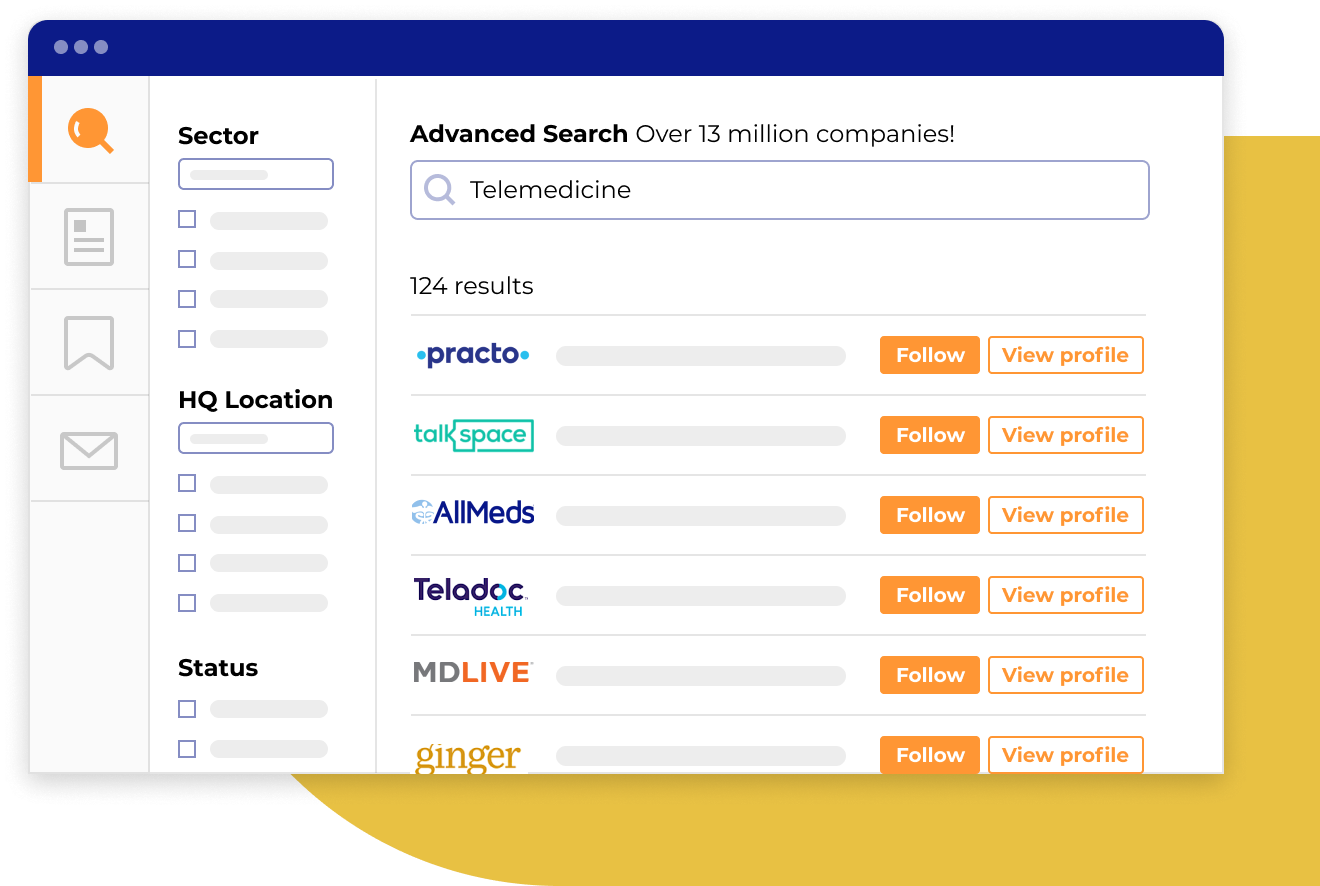
Owler is a platform that lets you search for hard-to-find contacts, get news alerts, and access exclusive company information. Using its advanced search feature, you can filter contacts by whatever criteria you want, including geography, industry, revenue, and more.
Track the companies you’re interested in, and keep up to date with their latest movements. With regular alerts, you can stay current with business events, including who’s expanding and who’s making layoffs. You can also keep tabs on the competition and monitor what people are saying about your company.
Starting price: $99.00/year
Features
- Company profiles
- Company databases
- Custom keyword alerts
- Brand customization
- Training
6. Leadfeeder

Leadfeeder is a prospecting tool for B2B businesses with at least one sales person. And it’s designed for tracking and monitoring website traffic. Leadfeeder hosts features for seeing which companies are checking out your website, what brought them there, and what they’re most interested in.
With a unique database of static and dynamic IPs, Leadfeeder even lets you track and identify remote workers looking at your site. See what visitors are viewing and build better sales pitches that speak directly to their needs.
Starting price: $63.00/month
Features
- B2B lead generation
- Channel attribution
- Conversion tracking
- Customer segmentation
- Engagement tracking
7. Demodesk

Demodesk is a platform for hosting lead meetings. Users can automate scheduling workflows and create automated calendar invites and reminders. Engage customers with interactive screen-sharing and collaborative meetings, where you can show slides, speaker notes, and web apps.
Personalize pitches and pull up relevant data directly into your meetings, and keep your sales narrative unified with Demodesk’s Team Playbooks feature. You can also build your own branded virtual sales room, setting up the right environment for making sales.
Demodesk promises to reduce lag time, eliminate embarrassing notifications, and provide high-security and high quality audio and video conferences.
Starting price: $19.00/month
Features
- Auto-dialer
- Call recording
- Communication management
- Content management
- HD audio/video
8. Mattermark
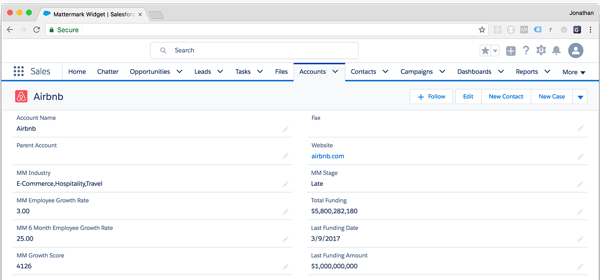
Mattermark lets you find and track companies and investors. Search by industry, location, revenue, and employee growth, and identify key personnel based on title and functions. Users build better outreach methods by using machine learning, natural language processing, and web crawlers to extract data from articles and websites.
Keep tabs on the businesses that are relevant to your market, and create your own scoring algorithms and models based on your company’s ICP. Then pull your Mattermark data into Microsoft Excel or Google Sheets for easy organization and retrieval.
Starting price: $49.00/month
Features
- List building
- Territory planning
- Data coverage
- Saved searches
- Automatic data field updates
9. Zoominfo
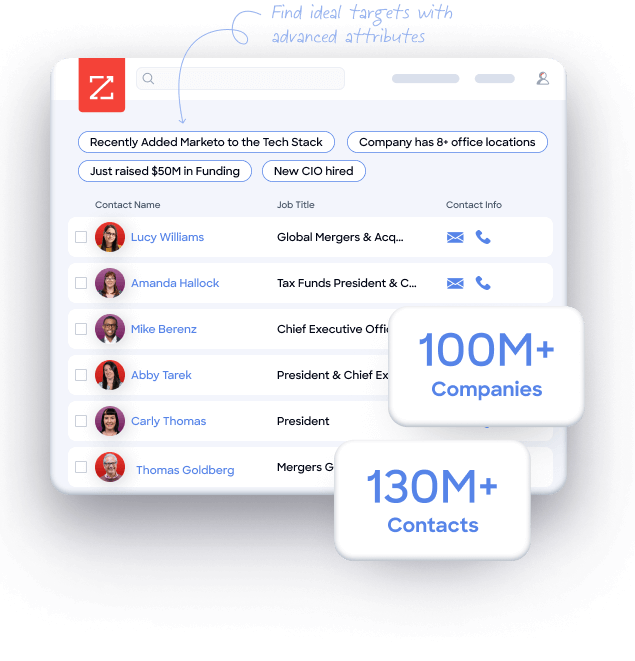
Zoominfo is a B2B database that lets you discover prospects in your target market, and build better engagement. Its contact and company search feature allows users to extract current professional and company data. Then it filters that by such details as work experience, education, web mentions, and certifications.
Build a tailored list of companies to target with 300+ attributes to choose from. Then analyze customer calls and interactions to extract better insight to inform business decisions. Using intent data, you can locate buyers at the beginning of their purchasing journey and track their consumption patterns.
Starting price: not provided by vendor
Features
- Customer profiles
- B2B lead generation
- Competitive analysis
- Customer segmentation
- Lead database integration
10. Hunter

Hunter is a cloud-based email finder tool that lets you locate and verify publicly available names and email addresses. You can search for contacts one by one, or enrich your database with bulk email searches. Then, Hunter’s email verifier automatically does a full check of the addresses in your list. So you can be confident that your database is correct and up-to-date.
Hunter’s Chrome extension lets you pull emails from the websites you’re looking at, then build lists on Google Sheets. It also has a cold email feature for creating and tracking campaigns and follow-ups.
Starting price: $49.00/month
Features
- List management
- Domain search
- Author finder
- Email finder
- Chrome extension
11. Datanyze
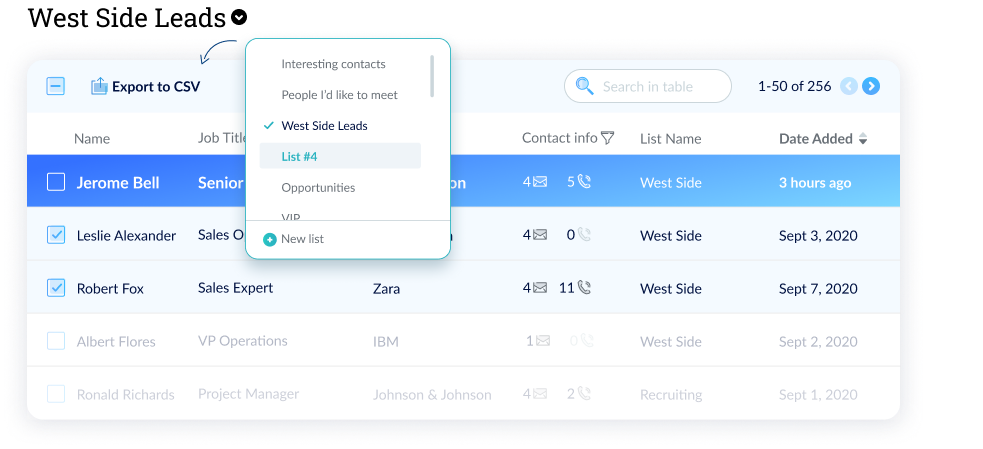
Datanyze is a platform for helping salespeople find B2B prospects. Gather contact information while browsing social media channels, and directly access data from company websites using the Datanyze Google Chrome extension feature.
Datanyze will also start hosting features for breaking the ice with potential customers in the near future. Use social media feeds and location news publications to dig up relevant talking points to get the conversation started. You can also segment lists by adding tags to contacts on your list, then export to CSV with a simple click.
Starting price: $55.00/month
Features
- Lead management
- Pipeline management
- Lead segmentation
- Data management
- Contact management
12. EverString
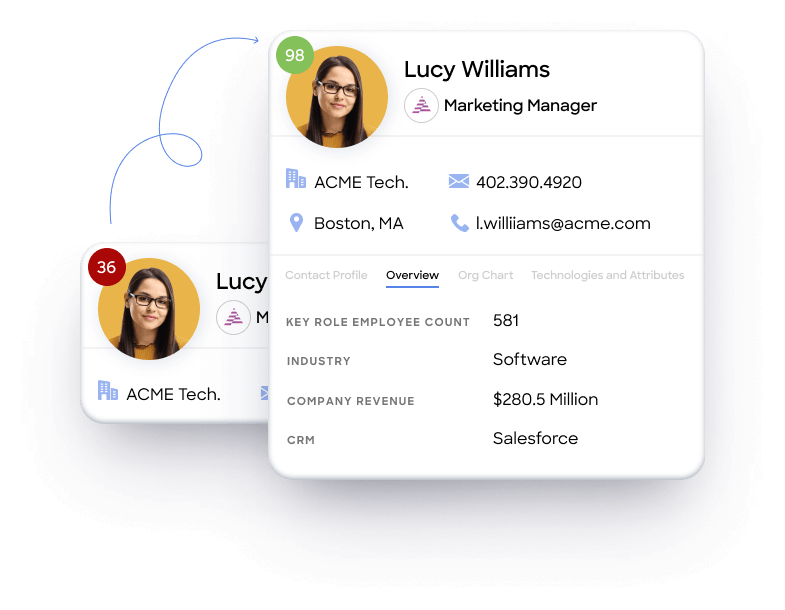
Now a part of Zoominfo, EverString is an AI-powered platform for building insightful data graphs. Unify your sales, marketing, and finance teams by gathering relevant data into a single source of truth. Users can also segment and prioritize contacts, and engage with influencers and decision makers.
Using diverse data like technographics and firmographics, your team can get the entire scope of the accounts you’re prospecting to. Other features include account-based marketing, market automation, company search, and workflow integration.
Starting price: $820.00/month
Features
- Analytics/ROI tracking
- Campaign personalization
- Contact management
- Customer database
- Engagement tracking
13. Prospect.io

Best for SMB businesses, Prospect.io is a tool for building email lists, creating impactful campaigns, and tracking results. Move prospects between lists easily, and use its powerful segmentation tool to send more personalized messaging to your contacts.
Easily import and export your data for sharing, and automatically add prospects to your workflow by setting up triggers with predefined criteria. Then, create a set of filters to direct prospects down one path or another, and use manual reviews to approve them before they continue into the workflow.
Starting price: $19.00/month
Features
- Lead management
- Performance metrics
- Proposal management
- Contact management
- Opportunity management
14. MailTester.com

MailTester is a cloud-based tool for stripping your email lists of spam traps and abandoned emails. Its algorithm verifies and categorizes every entry, then assigns emails into six different segments: deliverable, invalid, disposable, unknown, spamtraps, and accept all. Users can then download the segmented results into an XLSX or CSV file.
MailTester takes the guesswork out of email campaigns, increasing deliverability so that you know your campaigns are actually being seen. Plus, it has a customizable API that lets you prompt customers who may have mistakenly entered the wrong email. So they can input the correct address.
Starting price: $19/month
Features
- Bulk email verification
- Single email verification
- Dashboard
- Customizable API
- 4 API libraries
15. Yesware

Yesware is an email prospecting tool for Google and Outlook that lets users reach out to prospects, schedule meetings, and follow-up with leads right from their inbox. Users can see what’s working and where they need improvement with daily activity tracking features. The platform notifies you when emails are opened, view your attachments, or open links.
Using Yesware’s multi-channel campaign features, easily schedule automated emails and calls, and create thoughtful follow-ups. You can also build a library of your highest performing email templates, and share them with other people on your team.
Starting price: $15.00/month
Features
- A/B testing
- Audience targeting
- Event triggered actions
- Location tracking
- Performance metrics
16. BuiltWith
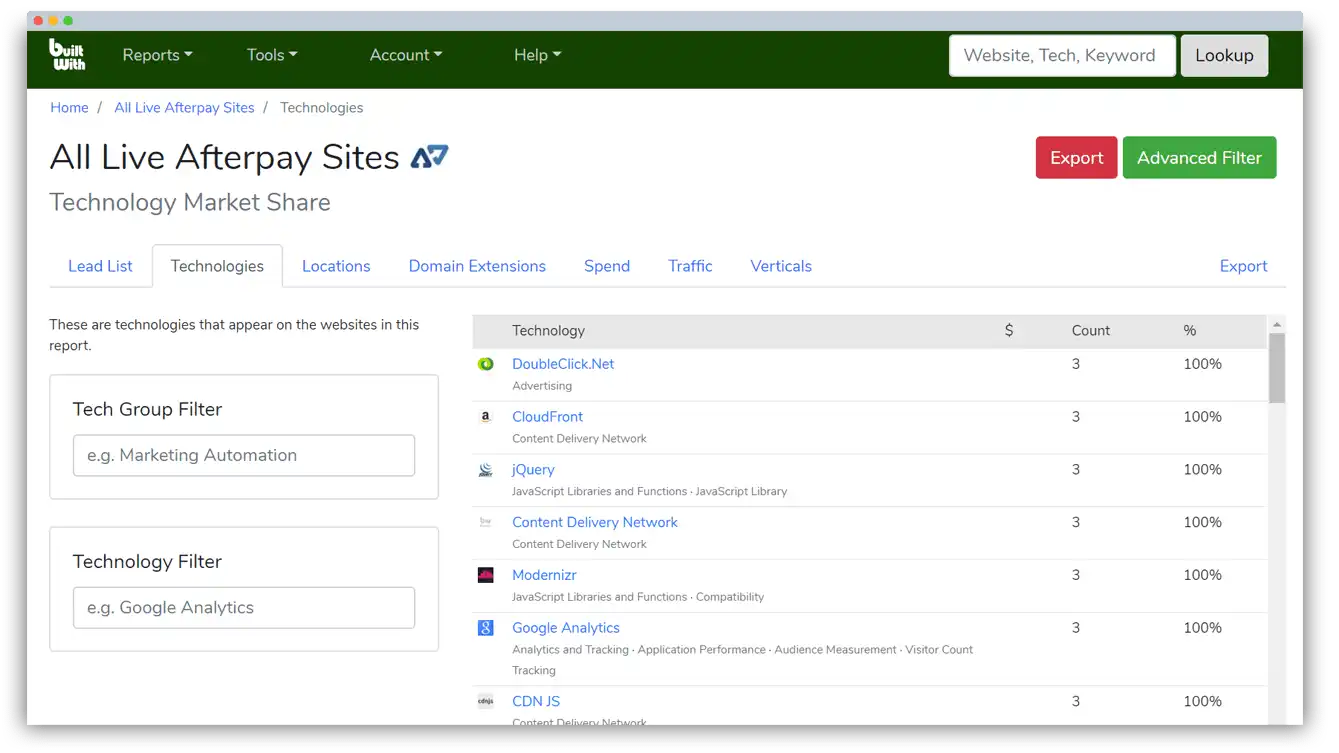
BuiltWith is a platform for pinpointing which technologies a company is currently using. Filter searches by location, traffic, vertical, and more, and download extensive lists of businesses using a particular platform.
With a database of over 53,000 web technologies and 673 million websites, you can see who’s using shopping carts, hosting, advertising, CMS, and analytics. Then, use its sales intelligence feature to better understand your prospect’s platform before starting a conversation. And with global data coverage spanning over 270 countries, users can get the full scope of their active market.
Starting price: $295.00/month
Features
- Contact database
- Lead capture
- Lead segmentation
- Data import/export
- Lead qualification
17. Clearbit Prospector

Clearbit lets you identify anonymous website visitors and track their activity, so you can see what’s generating the most interest. Firmographic data lets you personalize your visitor’s experience on your website in real-time. And then alert your sales team when one of their accounts shows intent.
Instantly gain a view of visitor’s info, such as their company size and location. Generate highly targeted account and lead lists, and automatically verify contact details so your lists are always up-to-date with the most current info. Create a preferred contact persona, and search for new target accounts by setting your own parameters.
Features
- Lead management
- Segmentation
- Performance metrics
- Source tracking
- Opportunity management
18. HubSpot Sales Hub

Sales Hub is a platform included in a larger suite of HubSpot’s business apps, which also include Marketing, Service, and CMS. It offers popular features like email templates, email tracking, document management and tracking, and call tracking and recording.
HubSpot’s conversation intelligence lets users capture relevant information from every call. Then, AI-powered insights let sales teams and managers know where additional training might be needed. Prioritize daily sales calls and reach out directly from your browser, and then automatically log them into your company’s CRM software.
Features
- Call management
- Referral tracking
- Performance metrics
- Contact management
- Lead management
Starting price: $50 per user per month
19. Sendoso

Sendoso is a sending platform for sending and tracking the ROI of anything your company sends in order to engage with and attract prospects. You can source and send gifts, perishables, company swag, handwritten notes, gift cards, and more, to build up relationships and increase engagement. You can also send personalized gifts and set up virtual events.
To make sure your gifts are working, track the return on your investments, and share those metrics with your stakeholders. Create memorable events like virtual wine tastings, and send eGifts to inspire people to attend your events.
Features
- Event triggered actions
- Progress tracking
- Delivery tracking
- Engagement tracking
- Mailer templates
20. Vidyard

Vidyard is a video tool for building virtual connections. Using online video, users can create personalized and interactive video experiences, and gain valuable insight into customer behavior and preferences. Send or share product demos, customer stories, executive updates, and more.
Create videos from your webcam or by recording your screen, edit and customize your thumbnail, and send through email, social media, or other channels. Viewers can watch your creations without downloading, and get valuable analytics about how your creations are performing.
Features
- Analytics/ROI tracking
- Social sharing
- Video editing
- Mobile screen support
- Multi-channel distribution
Starting price: $300 monthly for teams
Summary of the best sales prospecting tools
Appointment management | Content creation | Free trial | 24/7 live rep support | Contact database | Reporting/Analytics | |
|---|---|---|---|---|---|---|
|
✔
|
✔
|
✔
|
✔
|
✔
|
✔
|
|
X
|
X
|
✔
|
X
|
✔
|
X
|
|
X
|
X
|
✔
|
X
|
✔
|
X
|
|
X
|
X
|
✔
|
X
|
X
|
X
|
|
X
|
X
|
X
|
X
|
X
|
X
|
|
X
|
X
|
✔
|
✔
|
X
|
✔
|
|
X
|
X
|
✔
|
X
|
X
|
✔
|
|
X
|
X
|
✔
|
X
|
✔
|
X
|
|
X
|
X
|
✔
|
X
|
✔
|
✔
|
|
X
|
X
|
✔
|
X
|
X
|
X
|
|
X
|
X
|
✔
|
X
|
X
|
X
|
|
X
|
X
|
X
|
X
|
✔
|
✔
|
|
X
|
X
|
✔
|
X
|
X
|
X
|
|
X
|
X
|
X
|
X
|
X
|
X
|
|
X
|
X
|
X
|
X
|
X
|
X
|
|
✔
|
X
|
X
|
X
|
X
|
X
|
|
X
|
X
|
X
|
X
|
X
|
X
|
|
X
|
X
|
✔
|
X
|
X
|
X
|
|
X
|
X
|
X
|
✔
|
X
|
✔
|
|
X
|
✔
|
✔
|
✔
|
X
|
✔
|
How do you know which prospecting tool is worth your time and money?
The first step to choosing the best prospecting tool is to establish realistic and achievable prospecting goals. Talk to your sales team about the prospects they currently have in their pipeline, and where they’ve been dropping out. Ask them about potential customers who seemed promising at first, only to reveal later that they didn’t fit your desired criteria.
Consider your budget and your plans for growth. Then search for prospecting software tools with free trials, so you can give it a test run before laying down your money.
Frequently asked questions on sales prospecting
Begin sales prospecting with Zendesk
Ready to test drive free prospecting tracking software to see how it can help your business attract better qualified customers into your pipeline? Try Zendesk’s free CRM trial with a no-commitment test run, and experience the power of user-friendly sales prospecting software. Zendesk offers a host of features for streamlining your prospecting workflow, including lead management software, contact management software, and sales tracker functions.
